by Winding Pathways | Dec 14, 2023 | (Sub)Urban Homesteading, Bugs, Garden/Yard, Nature, Pests
Autumn Reveals Nature’s Wonders
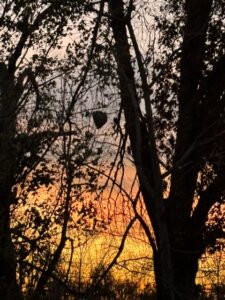
Bare trees reveal a bald-faced hornet nest.
November’s wind stripped the leaves off one of our maples and revealed a big gray football-shaped bald-faced hornet nest. Although we’d walked under it all summer, we had no clue it was there.
This fall many people will discover similar “paper wasp” nests in their trees or shrubs or even tucked near a light fixture. Made of a paper-like material, the nest was really made by insects called “bald-faced hornets” that are related to other wasps, including yellow jackets.
These social wasps can attack in droves. Their sting hurts. Because their stingers are smooth, unlike honey bees, they can sting again and again.
So, what do you do when you spot a nest on a crisp fall afternoon? Leave it alone!
Life History
The insect’s life history gives the best clue on how to avoid painful stings.
Last fall the colony of 500, or so, worker wasps died as the weather cooled. The fertile queen survived by tucking herself under a rotting log somewhere to slumber through winter. Come spring she’ll make a tiny paper-like nest, usually in a tree, and lay eggs that become workers. These hard-working new insects expand the nest and forage widely.
They are omnivores eager to dine on rotting fruit, but among their favorite foods are caterpillars and adult insects. Bald-faced hornets are a gardener’s friend, removing vegetable-chomping insects. They also sip on nectar so are good pollinators.
Aggressive or Protective?
Most sources claim they are highly aggressive, and they are if someone disturbs their nest. Several years ago, an adult neighbor spotted a nest above the doorway that the family had used all summer. He tried to knock it down and only damaged the nest. His misguided aggression unleashed an attack by dozens of upset bald-faced hornets. Stung many times, he’ll likely never again molest a nest.
We walked under and near the bald-faced hornet’s nest in our yard many times this summer and didn’t even know it was there. They didn’t attack us. Rather, they snacked on our vegetable gardens’ pests.
The lesson: leave these insects and their nest alone.
Ironically, by the time most people discover a nest in very late fall, the colony has already abandoned it. The best thing to do is NOTHING. Winter’s wind, rain, and snow will disintegrate the nest, and the queen will find a new spot to build next year’s colony.
by Winding Pathways | Jun 22, 2023 | (Sub)Urban Homesteading, Foraging, Mammals, Nature, Pests
Fish Camp Woes
This year a giant bear tore up the Popsie Fish Company’s camp near the remote Egegik River in Southwest Alaska before the salmon arrived. These huge brown bears are smart, hungry, and massively powerful.
Early Work on Salmon

Good Catch
Early in his career, Rich was a salmon biologist for the Alaska Department of Fish and Game, working near the Egegik River. While there he loved eating the most delicious fish……. Sockeye Salmon.
During the summer millions of wild salmon of five species swarm into Bristol Bay but the sockeye is the most abundant. They are caught by many commercial fishing companies who net them in the bay and along beaches. State biologists ensure that enough fish survive nets to ascend rivers, spawn, and produce plenty of young to keep the runs robust.
Remembering Salmon Dinners

Fresh salmon is a treat.
Nearly a half-century ago he and Marion, co-owners of Winding Pathways, moved to the Midwest where there are no Sockeye Salmon. But they love grilling salmon fillets they order from the Popsie Fish Company. It catches, processes, and ships frozen fillets. The Pattersons occasionally order a box. In addition to being delicious and healthy, Alaskan Sockeye salmon are wild fish managed as a sustainable resource.
Bears on the Prowl
This year Popsie Owner Tony Neal had a problem. Like all commercial fishermen, he and his staff arrived well before the salmon run to set up their camp and prepare for fishing. That’s when the trouble arrived.
A brown bear tore its way into their building. Take a look at the photos to see what the bear did. It’s a mess.
-

-
Bears are powerful. Photo Eric Handstad
-

-
The work room is all shambles after a bear tore it up. Photo Eric Handstad
There is good news. There’s enough time before the salmon arrive to get everything fixed and ready to catch those delicious fish. To see Popsie Fish Company staff in action take a look at their website www.popsiefishco.com.
Increasing Occurrences of Bears
Iowans occasionally report a bear sighting, especially in NE Iowa where the woods make great shelter and rivers excellent corridors to travel.
Bears are increasing across the country even in urban areas. Past photos in papers have shown a bear walking down a major road near New York City. A recent newspaper article reported how a bear crashed into an Avon, CT, bakery and gobbled up 60 cupcakes before lumbering off. At Cedar Lake, Denville, NJ, a mama bear, and three cubs were recently spotted walking along the road. Actually, that is a fairly common sighting. Residents spread the word so walkers will be alert.
-
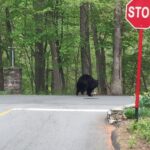
-
Suburban NJ has some prolific and big bears.
-
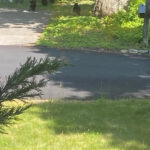
-
Bear and cubs. Photo Catherine Christ
The town police even fondly named one bruin “The Italian Bear.” Each night just after restaurants closed a fat bear would wander from its den, climb into the local Italian eatery’s dumpster, gorge itself, take a snooze, and come morning, climb out and go back to its secret den. Never hurt anyone.
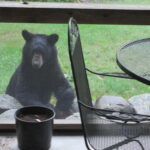
SRF took this pix of a bear peering in the window.
In rural New Hampshire, friends have had bears visit the yard and peek into the house through the windows frequently.
First Person Story

Picket fence was torn apart by a hungry spring-time bear.
Jackie and Peter Hull in Bedford, Virginia, shared this first-person story of the spring adventures with an unruly bear. “Well, I got up bright and early one spring morning, peeked out the bedroom window and what did I see? A smashed six-foot piece of picket fence, a broken spindle on the front porch, and a shepherd’s hook bent to the ground.
“Lucky me I brought the bird feeders in last night. So now I know I can’t feed the birds anymore this year. This is the second year running when on Mother’s Day last year, a bear came and smashed the spindles on the porch railing and a different six-foot piece of fence.
“Later we found bear tracks in the red Virginia clay bordering the flower bed on the outside of the fence. It left its muddy red prints on the fence and the steps going to the side door of the house!
“What to do but repair the fence again, wash the feeders, and put them in the basement? I have decided to store the leftover bird feed in a large bag in the freezer for next winter.
“I will miss my “bird buddies” but I don’t what a 250+ pound bear in my house either. So, words to the wise, the same ones the ranger gave me last year, ‘Bring your feeders in now.'”
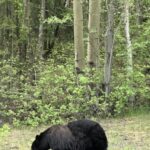
Alaskan Bear.
Back in Alaska, it is common even in suburban Anchorage neighborhoods to see a bear lumbering down a road. An Alaska-born, former Gazette editor spoke nonchalantly about bears and recess at schools. “We always had outdoor recess…except when a bear roamed the playground.”
Bears are about that is for sure!
by Winding Pathways | Jun 8, 2023 | Garden/Yard, Nature, Pests
A “Hard Knock Life”
A tick’s life is hard. I’m hungry. I am a tick and I’ve been waiting a week for a juicy raccoon, dog, or wild turkey to walk by. Even a mouse would be welcome.
So far, no luck. I know a tick’s best bet for grabbing a passing animal is the “questing” position, so I’ve been hanging on to a branch with both pairs of my hind legs. My front pair of legs sticks out into the path ready to grab the fur or feathers of a passing animal. So far, no animal. Patience is hard and I’m hungry.
Larval Luck
I was luckier last year when I was a larva. I was hungry then, too, but the wait was short. A big, furry animal humans call a dog ambled by. Even though I only had six legs then I was able to grab a hold, and the rest was easy. I crawled around exploring under the fur until I found a spot with soft thin skin, dug in, and chowed down. Boy was that blood tasty! It was so nutritious that I left my host to grow and graduate. I’m now a tick nymph, complete with eight legs, but I need more blood to transform into an adult.
I’m still hungry. As I sit waiting, I admire the mosquitoes and flies that buzz by over my perch. They don’t need to be patient but can fly and search for a blood-rich victim. I can’t fly or jump, so all I can do is patiently wait until something walks by. I hope that’s soon because many of my fellow ticks starve.
Attracted to Carbon Dioxide and Moisture
What’s this? I sense a bubble of carbon dioxide and moisture. Might be the breath of an animal. Now I feel the vibration of footsteps. Must be a big animal. My front legs are outstretched in anticipation and I’m not disappointed.
I grab hold of a strange animal. It’s tall with only two legs. No hair. No feathers. Just some sort of covering over thin skin. No chance of biting through it, but I got a good grip on that covering and started climbing using all of my eight legs. Soon I was under what humans call pants and kept exploring and climbing. Bingo, I found a nice moist spot where my blood dinner was just beneath thin skin. I got ready to feast.
Then something happened. I should be happy with a meal so close at hand. Instead, I felt sick. My legs wouldn’t hold on and I dropped to the ground lifeless.
About Ticks
Pity the poor tick the above. Well, maybe not. It’s hard to pity an animal that can spread disease and discomfort. Ticks usually feed on mammals, birds, and even reptiles but if none come around, human blood suits them just fine.
Ticks are effective disease spreaders because of their relatively long life which can extend for two or three years and their habit of eating a blood meal during different life stages. This enables them to bite one animal carrying a disease in its blood and inject it into a different animal during a later feeding.
Seriously Avoiding Ticks
At Winding Pathways, we take ticks seriously. Rich has had Lyme disease twice, fortunately successfully cured by strong antibiotics. Other people are not as lucky and experience long-term symptoms. And, Lyme is not the only disease ticks spread.
Understanding ticks and taking precautions reduces the odds a person will be bitten and contract a disease from them.
How ticks Operate
Ticks are ambush hunters. As the tick describes above, they wait for a victim to pass within grabbing distance of their front legs. Often ticks walk around on their victim for several hours before they dig through the skin and help themselves to a blood meal.
In order to contract a tick-borne disease a victim must be bitten, so a walking tick won’t transmit illness.
Reduce Your Odds
We often explore the woods, work in our yard and garden, and generally spend time in tick country. Here are precautions we take that reduce the odds of a tick bite:
- We spray our outdoor clothes and shoes with permethrin. It lasts for several washings and kills ticks. The hapless tick described above fell victim to this chemical.
- We often tuck our pants legs into our socks, sprayed with permethrin, to make it hard for any tick that gets on our socks or pants to get under them.
- After returning to the house, we disrobe and shower after we have checked for ticks. They prefer moist dark body areas so we especially check those places. Clothing goes into the washer.
- We watch for symptoms of Lyme Disease, especially a rash and fatigue. If they appear we call our physician immediately.
Promising Product
A few years ago, Rich was so determined to prevent another Lyme Disease incident that he invested in socks, pants, and shirts from Insect Shield. The company infuses its clothing with permethrin that, they claim, is effective for at least 70 washings.
Does this chemical work? Is Insect Shield clothing worth buying? Well, since wearing it Rich hasn’t found a tick on him and he’s been free of Lyme Disease. That’s not a scientific verdict but it’s good enough for him to keep wearing the clothes.
-
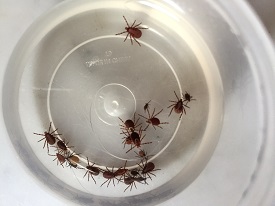
-
Tiny ticks can cause problems, so we go prepared in nature.
-
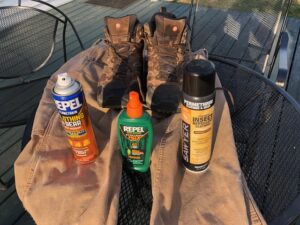
-
Pants, boots, varied sprays can reduce odds of picking up ticks
-
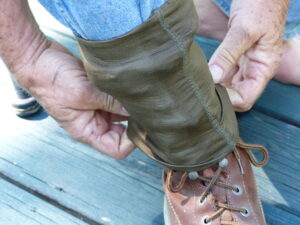
-
gaiters with tick guard helps repel ticks.
-
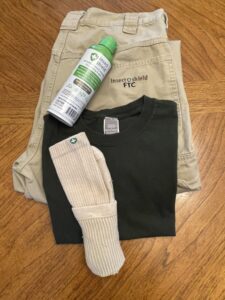
-
Pants, shirts, and socks infused with permethrin appear to keep ticks off.
Disclaimer
Rich purchased his Insect Shield clothing at the retail price. He’s still testing them but they seem to work. Winding Pathways was not paid for this blog.
by Winding Pathways | Feb 2, 2023 | Foraging, Nature, Pests, Trees, Trees/Shrubs
Disappearing Ash Trees
Ash trees are fast disappearing from American forests and towns. It’s tragic.
There are several ash species, including white, green, blue, and black. A Chinese native insect, the Emerald Ash Borer, is killing them all quickly. It’s awful.
Years ago, Dutch Elm Disease cleared cities of American elms, and many homeowners and towns planted green and white ash trees to replace them. Ashes, in general, thrive in the woods and towns. They grow relatively quickly, resist storm damage, and are beautiful. They seemed like an ideal urban tree.
That was true until Emerald Ash Borers were found in Michigan in 2002, although they may have been around at least a decade earlier. Since then, the insect has spread like crazy, killing ashes radiating outward from Michigan.
They reached Iowa years later and have since killed most of the trees in Cedar Rapids, area woodlands, and many other towns.
Salvaging Ash trees
Rich salvages wood from a scrap pile of used pallets. Pallets are made from cheap wood, like cottonwood, poplar, and hackberry, but now he’s finding ones made of ash.
Loggers are salvaging dead and dying ash trees, and the wood is cheap, at least for now. Soon ash lumber will no longer exist.
A Versatile Wood
Sports fans will miss ash wood. It makes the best baseball bats and has been used for gymnastic bars.
Ash also is crafted into gorgeous furniture.
We lost our big ash tree in the August 2020 derecho, but it was already infested with borers with its days numbered. Sadly, we cut the tree up but gave it a second task. It harvested solar energy and used it to make wood. That wood is now being fed, piece by piece, into our woodstove. It’s keeping our home warm, but we’d rather have our tree.
-

-
Ash bat on oak floor.
-

-
The ash tree anchored our east corner of the property.
-

-
White Ash bats will soon be a memory as these elegant trees die.
by Winding Pathways | Sep 15, 2022 | (Sub)Urban Homesteading, Birds, Garden/Yard, Mammals, Nature, Pests
Guest Blog by Jackie Hull,
in the foothills of Virginia
Bears Barely Tolerable Behavior
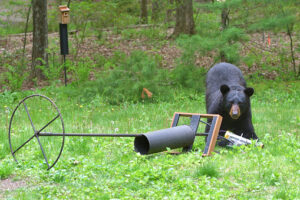
Bear Raiding Feeders
Well, the bear did it again. It tore up some of the spindles on the porch railing, tipped over a couple of the vegetable pots, and yanked a six-foot portion of our picket fence off the posts. All this to remind me that I should not feed the birds this time of year. It’s May.
So what to do but put away all the feeders? Maybe I can try again in the fall when bears retreat to the dens for their winter snooze.
This pretty much gave me great moments of sadness especially since I’ve had to shed other favorite activities.
Bird Antics Bring Joy
But today was a day of great surprises. My beautiful main stays, the birds, were everywhere. As I sat in the kitchen peering out the window, I spotted the adult turkeys poking their heads above the uncut hay. I could feel their parental thoughts “The coast is clear so keep scrambling forward.” The chicks were not seen but definitely there. A goldfinch zipped over them. Then I saw two wood thrashers near the holly tree scavenging for insects. Oh, my look how that crow struts!
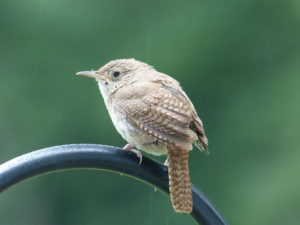
Wrens are Chatterers
Listen, that’s the wren by the back door. She keeps chattering to remind me she built her condo in the hanging planter. Then a flash of bright red caught my eye as I walked onto the porch. It’s a cardinal. Then the female house finch flicked from her nest over the front door light. She doesn’t like me stepping onto the porch. She is quite timid.
Even though the feeders have been down for nearly two months, the birds have kept their vigil at my country home much to my delight. They are in the trees, along the lane, and in the hayfield. What a great day!
by Winding Pathways | Feb 10, 2022 | Birds, Mammals, Nature, Pests
Guest Blogger, Dr. No More Squirrels
(Photos by Dr. NMS)
Much of my time and energy has been spent battling a 1-pound enemy – the gray squirrel. I love feeding and watching birds, but with a neighborhood full of acorn-bearing oak trees I feel no guilt at all at not wanting to pay for bird food and letting the squirrels eat it. Through trial and error, I have found how to place all our feeders so that they are always out of the reach of squirrels. Almost always. Every few months a new guy shows up; a determined daredevil squirrel who figures out how to slide 20 feet down the string holding a feeder to get to the mother lode.
-
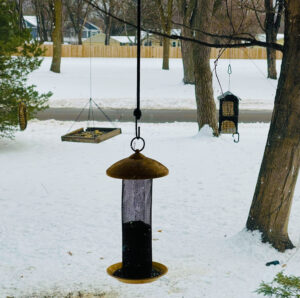
-
A variety of feeders for the birds.
-
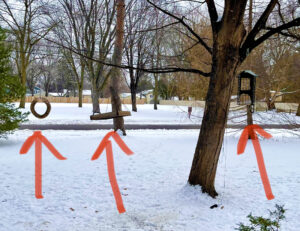
-
the “raiders” jump through hoops to get to the feeders.
When that happens, it’s time for an involuntary relocation.
This was the case on a frigid January morning here in Minneapolis. My live trap was set and within minutes I heard it snap shut. But what I then saw was a shock. The squirrel was trapped all right, but sitting next to the trap was an immature red-tailed hawk! She hopped onto the trap and all around it, trying to get at what she thought would be an easy breakfast.
Minutes later, she gave up and flew to a nearby perch to contemplate how she had been beaten by a 1-pound ball of gray fur.
I knew exactly how she felt.
-
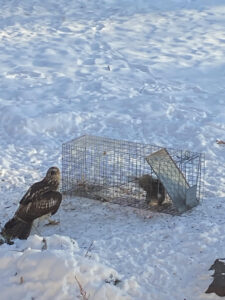
-
This immature red-tail hawk tries to figure out how to get the squirrel.
-
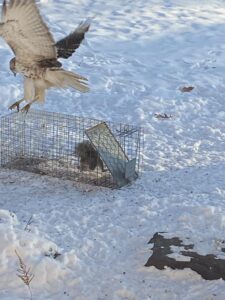
-
Landing on the trap























